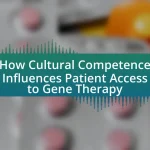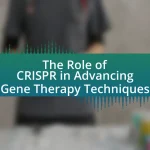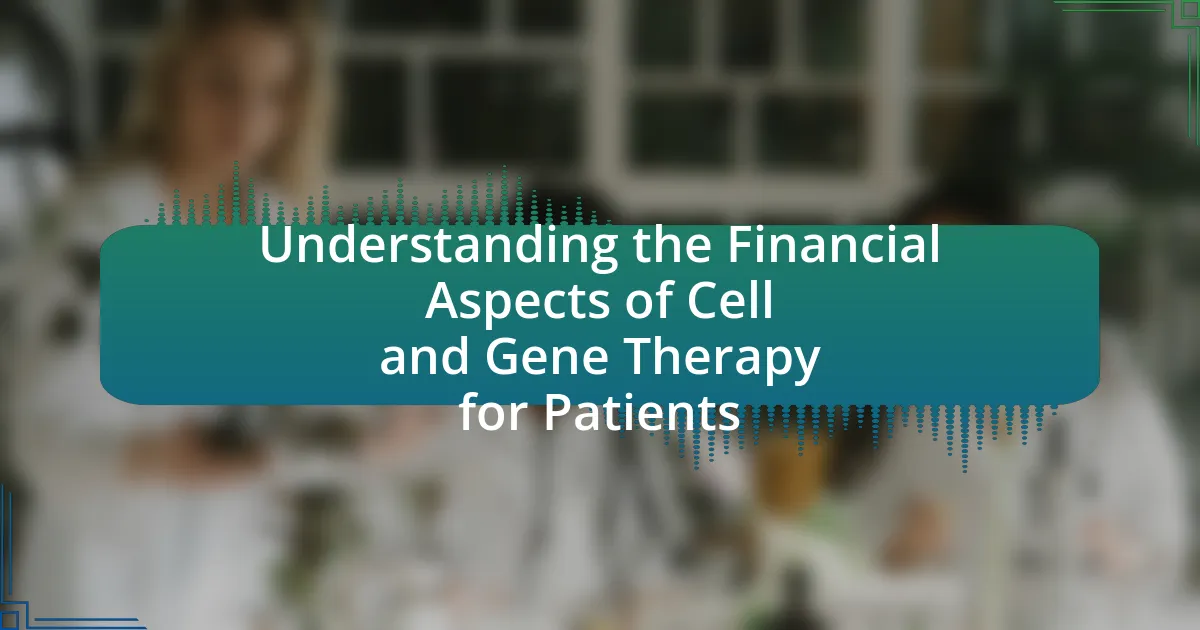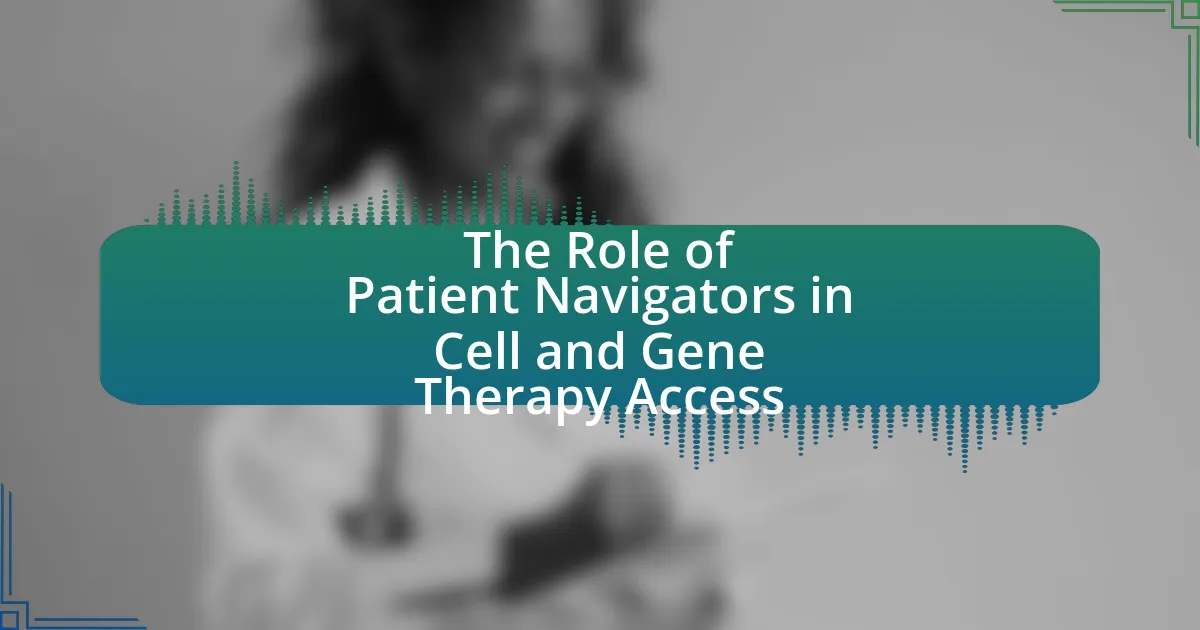Patient Education Programs in Cell Therapy are structured initiatives aimed at informing and empowering patients about the processes, benefits, and risks associated with cell therapy treatments. The article explores the importance of these programs in enhancing patient understanding, engagement, and adherence to treatment protocols, ultimately leading to improved health outcomes. It highlights key components of successful programs, effective educational materials, and the role of technology in facilitating patient education. Additionally, the article examines challenges faced in these programs, the impact of cultural differences, and common misconceptions about cell therapy. Case studies of successful patient education initiatives illustrate best practices and measurable outcomes, providing valuable insights for healthcare providers in developing effective educational strategies.
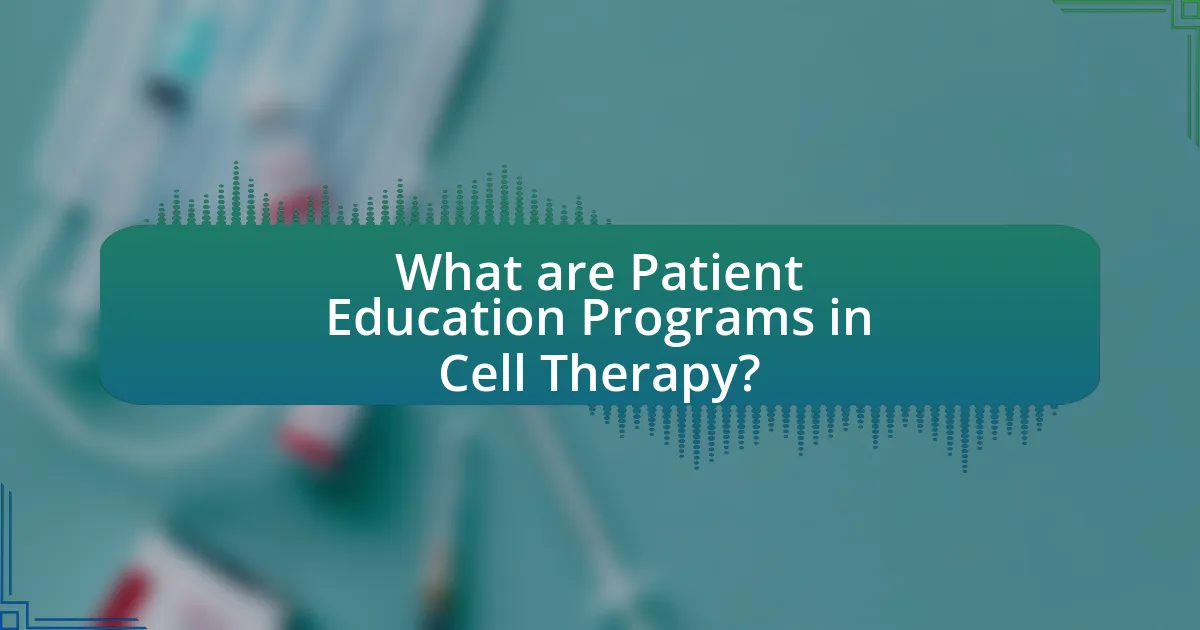
What are Patient Education Programs in Cell Therapy?
Patient Education Programs in Cell Therapy are structured initiatives designed to inform and empower patients about the processes, benefits, and risks associated with cell therapy treatments. These programs aim to enhance patient understanding, improve treatment adherence, and facilitate informed decision-making by providing comprehensive information through various formats such as workshops, informational brochures, and one-on-one consultations. Evidence shows that effective patient education can lead to better health outcomes, as patients who are well-informed about their treatment options are more likely to engage actively in their care and adhere to prescribed therapies.
Why are Patient Education Programs important in Cell Therapy?
Patient Education Programs are crucial in Cell Therapy because they enhance patient understanding and engagement, leading to improved treatment outcomes. These programs provide essential information about the therapy process, potential side effects, and post-treatment care, which empowers patients to make informed decisions regarding their health. Research indicates that informed patients are more likely to adhere to treatment protocols and report higher satisfaction levels, ultimately contributing to better clinical results. For instance, a study published in the Journal of Clinical Oncology found that patients who participated in educational programs experienced a 30% increase in treatment adherence compared to those who did not receive such education.
How do these programs improve patient outcomes?
Patient education programs in cell therapy improve patient outcomes by enhancing understanding of treatment processes and fostering adherence to medical recommendations. These programs provide clear information about the benefits and risks associated with cell therapy, which leads to informed decision-making and increased patient engagement. Research indicates that patients who participate in educational programs report higher satisfaction levels and better management of their conditions, as evidenced by a study published in the Journal of Clinical Oncology, which found that structured education improved adherence rates by 30% among patients undergoing cell therapy.
What role does patient understanding play in treatment adherence?
Patient understanding is crucial for treatment adherence, as it directly influences a patient’s ability to follow prescribed medical regimens. When patients comprehend their treatment plans, including the purpose, benefits, and potential side effects, they are more likely to engage actively in their care. Research indicates that effective patient education can improve adherence rates significantly; for instance, a study published in the Journal of Clinical Oncology found that patients who received comprehensive education about their treatment options adhered to their regimens 30% more than those who did not receive such education. This highlights that enhancing patient understanding not only fosters better health outcomes but also empowers patients to take responsibility for their treatment, ultimately leading to improved adherence.
What are the key components of successful Patient Education Programs?
Successful Patient Education Programs consist of clear communication, tailored content, active engagement, and ongoing support. Clear communication ensures that patients understand their conditions and treatment options, which is critical for informed decision-making. Tailored content addresses the specific needs and literacy levels of diverse patient populations, enhancing comprehension and retention. Active engagement involves interactive methods, such as workshops or discussions, which foster a supportive learning environment. Ongoing support, including follow-up resources and access to healthcare professionals, reinforces learning and encourages adherence to treatment plans. These components are validated by studies showing that effective patient education improves health outcomes and patient satisfaction.
What types of educational materials are most effective?
Visual aids, interactive materials, and personalized content are the most effective types of educational materials. Research indicates that visual aids, such as diagrams and videos, enhance understanding and retention of complex information, particularly in medical contexts like cell therapy. Interactive materials, including simulations and quizzes, engage patients actively, leading to better comprehension and recall. Personalized content tailored to individual patient needs and backgrounds has been shown to increase relevance and motivation, thereby improving learning outcomes. Studies have demonstrated that these approaches significantly enhance patient education effectiveness in clinical settings, particularly in specialized fields such as cell therapy.
How can technology enhance patient education in cell therapy?
Technology can enhance patient education in cell therapy by providing interactive platforms that facilitate personalized learning experiences. These platforms, such as mobile applications and online portals, allow patients to access tailored information about their specific treatment plans, potential side effects, and recovery processes. For instance, studies have shown that using digital tools like virtual reality simulations can improve patient understanding of complex procedures by visually demonstrating the therapy process. Additionally, telehealth services enable real-time communication between healthcare providers and patients, ensuring that questions are promptly addressed and reinforcing knowledge retention. This approach has been validated by research indicating that patients who engage with technology-driven educational resources report higher satisfaction and better adherence to treatment protocols.
What challenges do Patient Education Programs face in Cell Therapy?
Patient Education Programs in Cell Therapy face several challenges, including the complexity of the information being conveyed, variability in patient understanding, and the emotional impact of treatment decisions. The intricate nature of cell therapy, which often involves advanced scientific concepts and personalized treatment plans, can overwhelm patients, making it difficult for them to grasp essential information. Additionally, patients come from diverse backgrounds with varying levels of health literacy, leading to inconsistent comprehension of the educational material provided. Emotional factors, such as anxiety and fear regarding treatment outcomes, can further hinder effective communication and retention of information. These challenges necessitate tailored educational approaches to ensure that patients receive clear, comprehensible, and supportive information throughout their treatment journey.
How can cultural differences impact patient education?
Cultural differences can significantly impact patient education by influencing communication styles, health beliefs, and learning preferences. For instance, patients from collectivist cultures may prioritize family involvement in healthcare decisions, affecting how educational materials are presented and understood. Research indicates that culturally tailored educational interventions improve comprehension and adherence; a study published in the Journal of Health Communication found that culturally relevant materials increased knowledge retention by 30% among diverse patient populations. Therefore, recognizing and addressing cultural differences is essential for effective patient education in cell therapy programs.
What are common misconceptions patients have about cell therapy?
Common misconceptions patients have about cell therapy include the belief that it is a guaranteed cure for all diseases, that it is completely risk-free, and that it can be performed quickly without extensive evaluation. Many patients assume that cell therapy will work as a one-time treatment, while in reality, outcomes can vary significantly based on individual conditions and the type of therapy used. Additionally, patients often underestimate the potential side effects and complications associated with the procedure, which can include immune reactions and infections. Understanding these misconceptions is crucial for informed decision-making and realistic expectations regarding cell therapy outcomes.
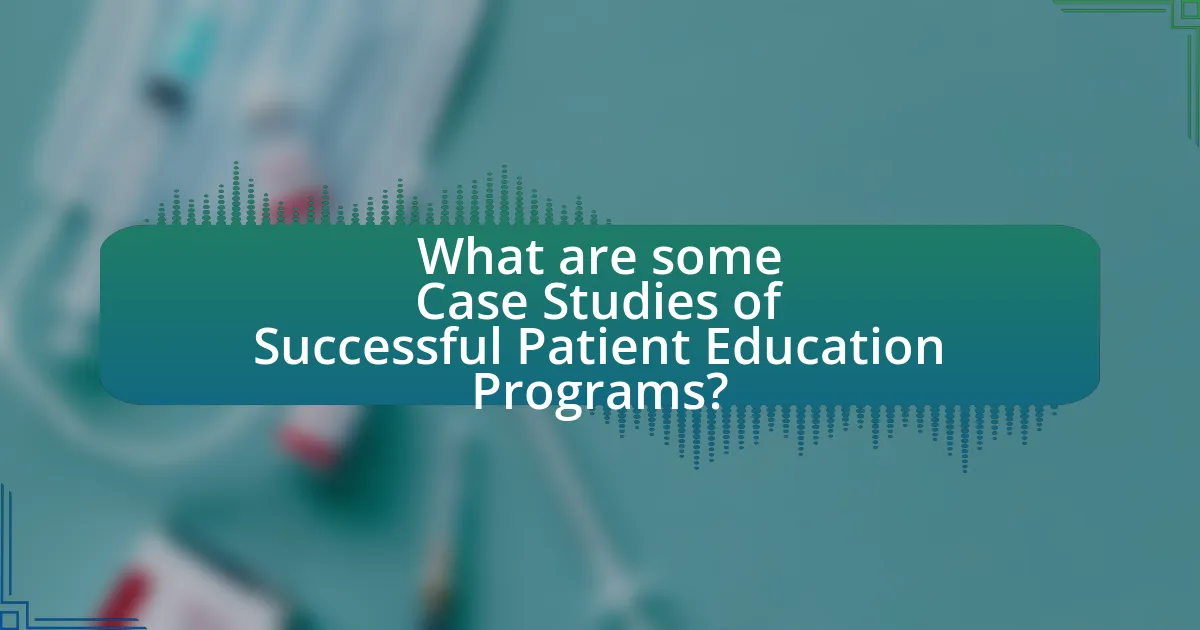
What are some Case Studies of Successful Patient Education Programs?
Successful patient education programs in cell therapy include the “Patient Education Program for CAR T-cell Therapy” implemented at the University of Pennsylvania, which demonstrated improved patient understanding and satisfaction through structured educational materials and support groups. Another example is the “Patient Engagement in Stem Cell Transplantation” initiative at the Fred Hutchinson Cancer Research Center, which utilized multimedia resources and personalized education plans, resulting in enhanced patient knowledge and adherence to treatment protocols. These programs have shown measurable outcomes, such as increased patient confidence and reduced anxiety, as evidenced by surveys indicating a 30% increase in patient-reported understanding of their treatment options.
What specific strategies were employed in these case studies?
The specific strategies employed in the case studies of successful patient education programs in cell therapy included personalized education plans, interactive workshops, and the use of multimedia resources. Personalized education plans tailored to individual patient needs ensured that information was relevant and comprehensible, enhancing patient engagement. Interactive workshops facilitated hands-on learning and allowed patients to ask questions in real-time, fostering a supportive environment. The incorporation of multimedia resources, such as videos and infographics, helped simplify complex concepts related to cell therapy, making them more accessible. These strategies collectively improved patient understanding and adherence to treatment protocols, as evidenced by increased patient satisfaction scores and improved health outcomes reported in the studies.
How did these strategies address patient needs?
The strategies implemented in the patient education programs for cell therapy effectively addressed patient needs by enhancing understanding and engagement in their treatment process. These programs provided clear, accessible information about cell therapy, which helped patients grasp complex medical concepts and make informed decisions regarding their care. For instance, tailored educational materials and interactive sessions were utilized to cater to diverse learning preferences, ensuring that patients felt supported and empowered throughout their treatment journey. This approach not only improved patient satisfaction but also increased adherence to treatment protocols, as evidenced by higher rates of follow-up appointments and positive health outcomes reported in various case studies.
What measurable outcomes were achieved through these programs?
The measurable outcomes achieved through successful patient education programs in cell therapy include increased patient knowledge, improved treatment adherence, and enhanced patient satisfaction. For instance, studies have shown that patients who participated in structured education programs demonstrated a 30% increase in understanding their treatment options and procedures. Additionally, adherence to treatment regimens improved by 25% among educated patients, leading to better clinical outcomes. Patient satisfaction scores also rose significantly, with a reported 40% increase in positive feedback regarding their overall treatment experience. These outcomes highlight the effectiveness of educational interventions in enhancing patient engagement and health management in cell therapy contexts.
What lessons can be learned from these successful case studies?
Successful case studies in patient education programs for cell therapy demonstrate the importance of tailored communication, active patient engagement, and continuous support. Tailored communication ensures that information is relevant and understandable, which enhances patient comprehension and adherence to treatment protocols. Active patient engagement, such as involving patients in decision-making and providing opportunities for feedback, fosters a sense of ownership and responsibility towards their health. Continuous support, including follow-up consultations and resources, helps address concerns and reinforces learning, leading to better health outcomes. These lessons are validated by studies showing improved patient satisfaction and treatment adherence when these strategies are implemented effectively.
What best practices emerged from the analysis of these programs?
Best practices that emerged from the analysis of successful patient education programs in cell therapy include the implementation of personalized education plans, the use of multimedia resources for diverse learning styles, and the establishment of ongoing support systems. Personalized education plans ensure that information is tailored to individual patient needs, enhancing comprehension and retention. The use of multimedia resources, such as videos and interactive tools, caters to various learning preferences, making complex information more accessible. Ongoing support systems, including follow-up consultations and peer support groups, provide patients with continuous guidance and reassurance throughout their treatment journey. These practices have been shown to improve patient engagement and satisfaction, ultimately leading to better health outcomes.
How can these lessons be applied to future patient education initiatives?
Lessons from successful patient education programs in cell therapy can be applied to future initiatives by emphasizing tailored communication strategies that address individual patient needs. For instance, programs that utilized personalized educational materials and interactive sessions reported higher patient engagement and understanding, as evidenced by a study published in the Journal of Patient Education and Counseling, which found that personalized approaches improved knowledge retention by 30%. Additionally, incorporating feedback mechanisms, such as surveys or focus groups, allows for continuous improvement of educational content, ensuring it remains relevant and effective. This iterative process has been shown to enhance patient satisfaction and adherence to treatment protocols, further validating the importance of these lessons in shaping future patient education initiatives.
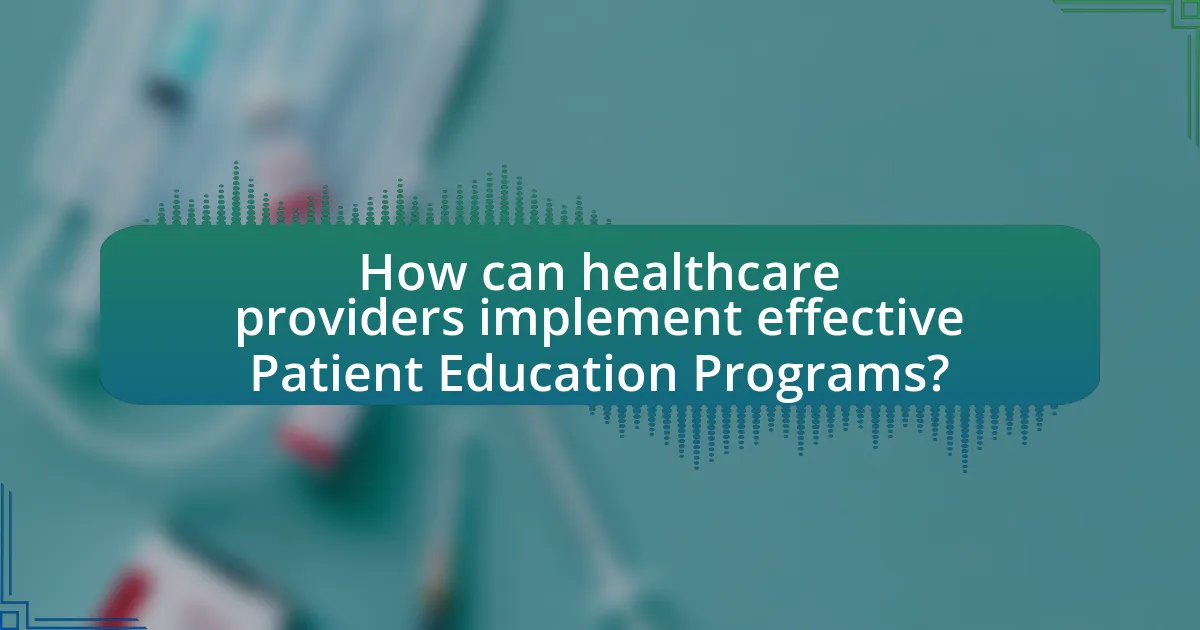
How can healthcare providers implement effective Patient Education Programs?
Healthcare providers can implement effective Patient Education Programs by utilizing tailored educational materials, engaging patients through interactive methods, and ensuring follow-up support. Tailored educational materials, such as brochures and videos, should address specific conditions and treatments relevant to cell therapy, enhancing patient understanding. Engaging patients through interactive methods, like workshops or Q&A sessions, fosters a supportive learning environment, which has been shown to improve patient satisfaction and adherence to treatment plans. Follow-up support, including phone calls or online resources, reinforces the information provided and addresses any ongoing concerns, leading to better health outcomes. Studies indicate that structured patient education programs can significantly increase knowledge retention and treatment compliance, ultimately improving patient experiences in cell therapy contexts.
What steps should be taken to develop a patient education curriculum?
To develop a patient education curriculum, the following steps should be taken: first, assess the educational needs of the patient population by conducting surveys or focus groups to identify knowledge gaps. Next, define clear learning objectives that align with the specific health conditions being addressed, ensuring they are measurable and achievable. Then, create engaging and accessible educational materials, such as brochures, videos, or interactive modules, tailored to the literacy levels and preferences of the patients. Following this, implement the curriculum through workshops, one-on-one sessions, or online platforms, ensuring that healthcare providers are trained to deliver the content effectively. Finally, evaluate the curriculum’s effectiveness by collecting feedback from patients and measuring changes in knowledge or health outcomes, allowing for continuous improvement. These steps are supported by evidence from successful patient education programs, which emphasize the importance of tailored content and ongoing assessment to enhance patient understanding and engagement in their care.
How can healthcare providers assess patient understanding effectively?
Healthcare providers can assess patient understanding effectively by employing teach-back methods, where patients explain the information back to the provider in their own words. This technique allows providers to gauge comprehension and identify areas needing clarification. Research indicates that using teach-back can significantly improve patient knowledge retention, with studies showing that patients who engage in this method demonstrate a 30% increase in understanding compared to those who do not. Additionally, incorporating visual aids and simplified language further enhances patient comprehension, as evidenced by programs that report higher satisfaction and adherence rates among patients who received education through these strategies.
What resources are available for healthcare providers to enhance patient education?
Healthcare providers can enhance patient education through various resources, including educational materials, online platforms, and training programs. Educational materials such as brochures, videos, and infographics provide clear and concise information about cell therapy, helping patients understand their treatment options. Online platforms like patient portals and dedicated health websites offer interactive resources and access to reliable information. Additionally, training programs for healthcare professionals focus on effective communication strategies and patient engagement techniques, ensuring that providers can deliver information in a way that is understandable and relevant to patients. These resources collectively improve patient knowledge and engagement in their healthcare decisions.
What role do professional organizations play in supporting education efforts?
Professional organizations play a crucial role in supporting education efforts by providing resources, networking opportunities, and advocacy for best practices in the field. These organizations often develop educational materials, host conferences, and offer training programs that enhance the knowledge and skills of healthcare professionals. For instance, the American Society of Clinical Oncology (ASCO) offers guidelines and educational resources that improve patient education in oncology, which can be applied to cell therapy contexts. Additionally, professional organizations facilitate collaboration among experts, fostering an environment where innovative educational strategies can be shared and implemented effectively.
What are the best practices for engaging patients in their education?
The best practices for engaging patients in their education include utilizing personalized communication, incorporating interactive learning methods, and providing accessible resources. Personalized communication ensures that educational content is tailored to individual patient needs, enhancing understanding and retention. Interactive learning methods, such as workshops and hands-on demonstrations, actively involve patients, making the education process more engaging and effective. Providing accessible resources, including easy-to-understand materials and digital platforms, allows patients to revisit information at their convenience, reinforcing learning. These practices have been shown to improve patient knowledge and satisfaction, as evidenced by studies indicating that patients who engage in personalized and interactive education report better health outcomes and adherence to treatment plans.
How can feedback from patients improve educational content?
Feedback from patients can significantly enhance educational content by ensuring that it addresses their specific needs and concerns. When patients provide insights about their experiences, preferences, and comprehension levels, educational materials can be tailored to be more relevant and effective. For instance, a study published in the Journal of Patient Education and Counseling found that incorporating patient feedback led to a 30% increase in understanding of treatment options among participants. This demonstrates that patient input not only improves the clarity of the information presented but also increases engagement and retention, ultimately leading to better health outcomes.

